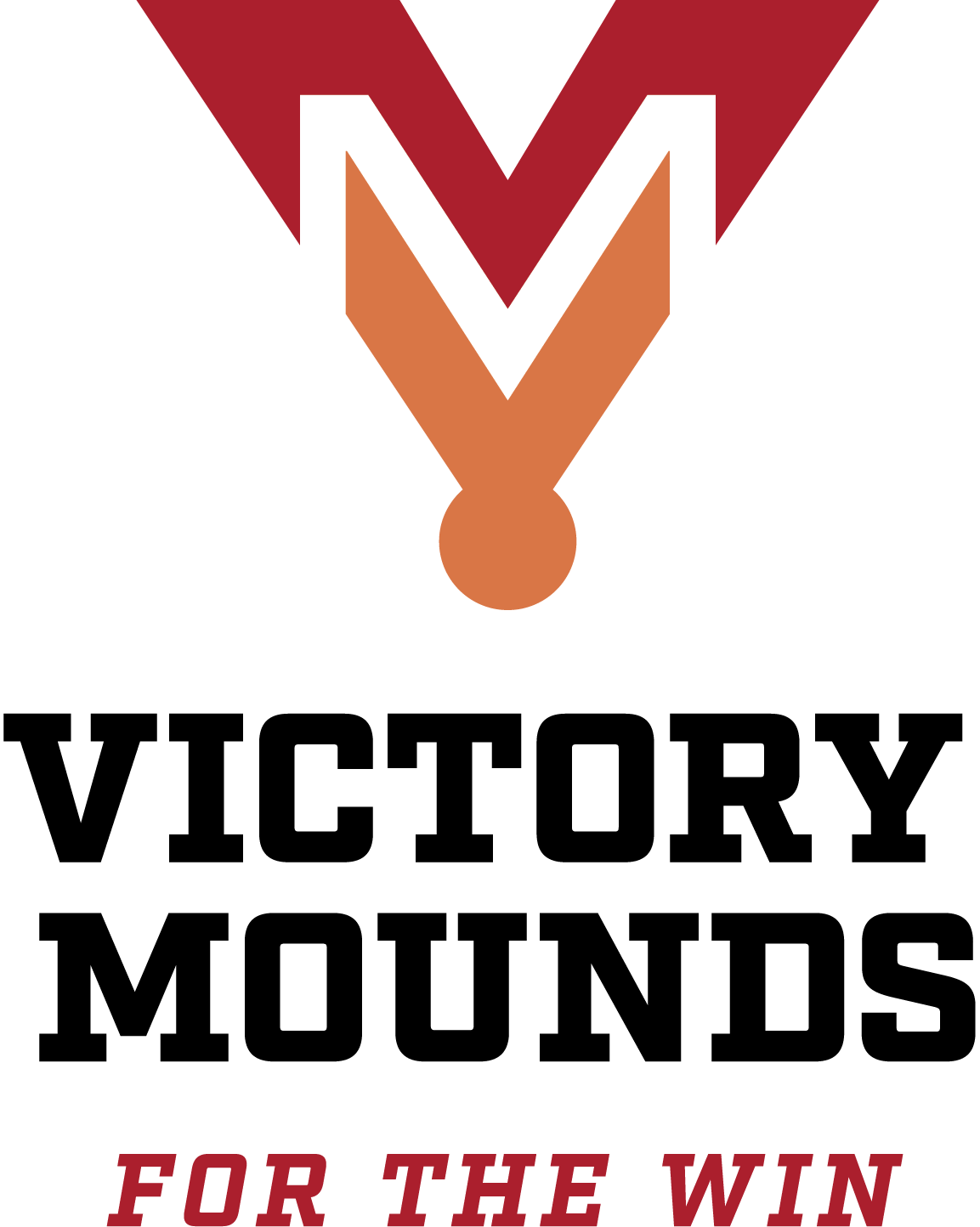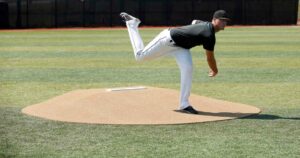Whether you’re a coach or a player, you know that high school baseball is where the rubber meets the road when it comes to skill development. That’s especially important when it comes to pitching, which means it’s critical to use a high school pitching mound that conforms to the necessary measurements. But there’s a lot more to it than that. If you’re going to be practicing both indoors and outdoors, you need a high school pitching mound that will stand up to practice repetitions and duplicate game conditions exactly. At Victory Mounds, making a pitching mound or a baseball mound is a big part of what we do for a living, so we happen to be experts on the subject.
Pitching Mounds in High School Baseball
Let’s start by talking about pitchers and pitching in high school baseball. At the lower levels, skill development is mostly about throwing strikes, hitting the catcher’s target and building enough arm strength to develop velocity. In high school, though, everything changes. Not that it’s not important to throw strikes, throw hard and hit the target—those requirements don’t change at any level, especially as you climb the skills ladder to high school and beyond. But high school hurlers have to be able to do a lot more than that. They need to be able to locate, throw strikes at different speeds, and occasionally they need to throw inside.
Hitters get stronger and become more sophisticated, too, so it’s important to change their eye level with different pitches and keep them off balance, too. That means curve balls, change-ups, and breaking balls. The development process is faster for some high school pitchers than others, but that’s part of separating the wheat from the chaff. The rewards are significant. College scholarships are worth tens of thousands of dollars, and for those who make it to the big leagues, millions may be involved. So while a high school pitching mound might seem trivial to casual fans, rest assured that coaches and would-be prospects take it very seriously.
Dimensions of High School Pitching Mounds
So let’s start with the basics. Specifically, what are the proper dimensions of a high school pitching mound? The mound circle is the most basic dimension. It has to be 18 feet in diameter, and the height has to be exactly 10 inches higher than home plate. But there’s more. The distance to home plate has to be 60 feet, 6 inches, and that measurement is taken from the back of home plate to the front of the rubber.
The rubber, which is a slab in the middle of the mound that pitchers use for balance, stability and continuity, comes with its own set of dimensions. It has to be 24 inches long and 6 inches wide, and it has to be correctly centered to home plate. The material for the white rubber slab is important, too, as it can’t be too spongy or slippery.
Baseball Mound Materials and a Turface Baseball Professional Pitching Mound
While some high school pitching mounds are built using ordinary dirt, the better ones are built using specialized, high-density virgin clay. This clay is made by a variety of companies that go by different names like Diamond Pro, Turface Professional Mound, and so on. This clay is specifically made to be stable and durable in the landing area so that pitchers can take a full stride into the landing area without having to worry about their spikes catching. The mounds are constructed out of clay bricks, with a set number being used for each area of the mound. Exactly 63 bricks are used for the top platform of the mound, while 36 are used for the stride area and another 81 for the landing area.
Using Portable Baseball Pitching Mounds on a High School Baseball Field
Not all high school pitching mounds are that precise, however. Some are built out of ordinary dirt, and while this can be dangerous, it does get the job done in most circumstances. But what about practice mounds? At the high school level, game fields often aren’t available until actual scheduled games begin, and some practice fields are on the shoddy side.
There is a remedy to this, however. Companies like Victory Mounds make portable pitching mounds that replicate the exact dimensions of high school pitching mounds, which means that pitchers can develop skills consistently and effectively. These portable practice mounds may not be made of specialty clays like Turface, but they do offer other advantages. Especially because they’re tough and durable, which means pitchers can experiment with pitching from different spots on the rubber.
Both the landing area and the entire mound area is made of reinforced Astroturf, so pitchers can experiment with pickoff moves as well. The durability of these mounds means they’ll stand up to the pound of hundreds of practices, and they can eliminate the need for dozens of hours of manual labor that’s necessary to build a practice or game mound from scratch.
High School Baseball Pitching Mounds & Practice Habits
Another advantage of using practice mounds for high school baseball is they help develop solid practice habits. Knowing that the dimensions are precise gives coaches the peace of mind that comes with knowing skill development is being done properly, to the point where pitchers can work on their skills during both batting practice and fielding drills. The improvements that come with a synchronized, effective practice are obvious. Players improve at a faster rate, and their focus tends to be better because they’re more involved. Rather than standing around waiting for something to happen, players can shift seamlessly from one drill to another, sharpening their skills and enjoying a practice process that’s a lot more fun and productive.
Summary
Pitching Mound for Skill Development
The use of a regulation high school pitching mound is essential for the development of skills in high school baseball. Pitchers at this level need to do more than simply throw strikes and hit the target. They must learn to locate pitches, vary speeds, and keep hitters off balance with different pitches such as curveballs and change-ups. The dimensions of a high school pitching mound are standardized to ensure consistency and create game-like conditions.
Pitching Mound Details
The mound circle, with a diameter of 18 feet, and a height exactly 10 inches higher than home plate, is a fundamental dimension. The distance from the back of home plate to the front of the rubber must be 60 feet, 6 inches. The rubber itself, a slab in the middle of the mound, must be 24 inches long, 6 inches wide, and properly centered to home plate. The material of the rubber is also important, as it should provide stability without being too spongy or slippery.
Pitching Mound Materials
While some high school pitching mounds are constructed using ordinary dirt, it is preferable to use specialized, high-density clay for better stability and durability. This clay, found in products like Turface Professional Mound, allows pitchers to confidently stride into the landing area without worrying about their spikes catching. Portable pitching mounds can be used for practice when game fields are unavailable or when practicing on less optimal fields. These portable mounds replicate the exact dimensions of high school pitching mounds, providing consistency and allowing pitchers to develop their skills effectively.
Benefits of Using a Pitching Mound
Using practice mounds not only ensures precise dimensions but also promotes solid practice habits. Coaches can have peace of mind knowing that skills development is being done properly and that pitchers can work on their skills during various drills. This synchronized and effective practice leads to faster improvements, increased focus, and a more enjoyable and productive practice experience for players. By utilizing the appropriate pitching mound, high school baseball players can hone their skills and increase their chances of success, whether it be earning college scholarships or pursuing a career in professional baseball.
FAQs
1) Why does baseball have a mound?
The mound in baseball serves several purposes. It provides an elevated platform for the pitcher to deliver the ball, giving them a mechanical advantage and allowing them to generate more velocity and movement on their pitches. It also creates a downward trajectory for pitches, making it more challenging for hitters to make solid contact. The mound helps balance the game between pitchers and hitters, adding an element of strategy and skill to the sport.
2) How far is the pitcher’s mound from home plate in high school baseball?
In high school baseball, the distance from the pitcher’s mound to home plate is 60 feet, 6 inches. This measurement is standardized across different levels of baseball, including high school, college, and professional leagues.
3) How far is it from home plate to the pitcher’s mound in major league baseball?
In Major League Baseball (MLB), the distance from home plate to the pitcher’s mound is also 60 feet, 6 inches. The distance remains the same across all levels of professional baseball.
4) What height baseball pitching mound do I need?
The height of a baseball pitching mound depends on the level of play. In high school baseball, the pitching mound should be 10 inches higher than home plate. This height differential helps create the necessary downward angle for pitches and adds to the difficulty for hitters. It is important to adhere to the specified height to ensure fair and consistent gameplay.
5) How far is home plate to the pitcher’s mound?
The distance from home plate to the pitcher’s mound, both in high school baseball and major league baseball, is 60 feet, 6 inches. This distance is measured from the back of the home plate to the front of the rubber on the pitcher’s mound.
Get the Best High School Pitching Mound for Your Needs
The good news is that there are even more benefits to these mounds that pertain to skill training, so the next step is to call us to find out about them. We’ve been making quality baseball equipment for years, and we have a lot of expertise. We’ll answer your questions, as a few of our own about your program and needs, then recommend a product. You’ll be happy with what you get, so go to VictoryMounds.com to learn more about our products, then call us at 800 835 9460. If you’d prefer to email, you can contact is at info@victorymounds.com

